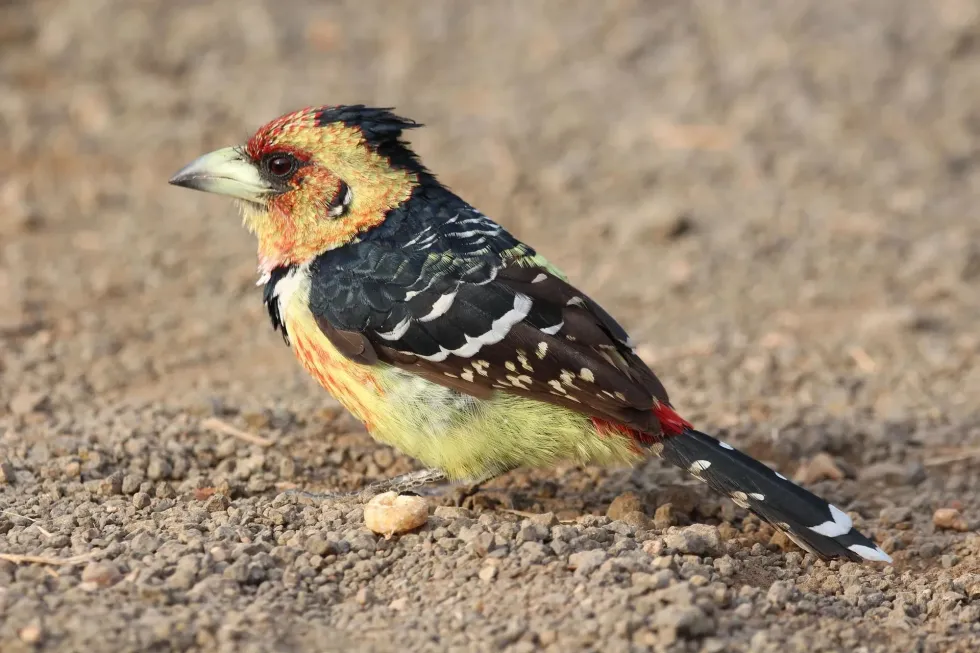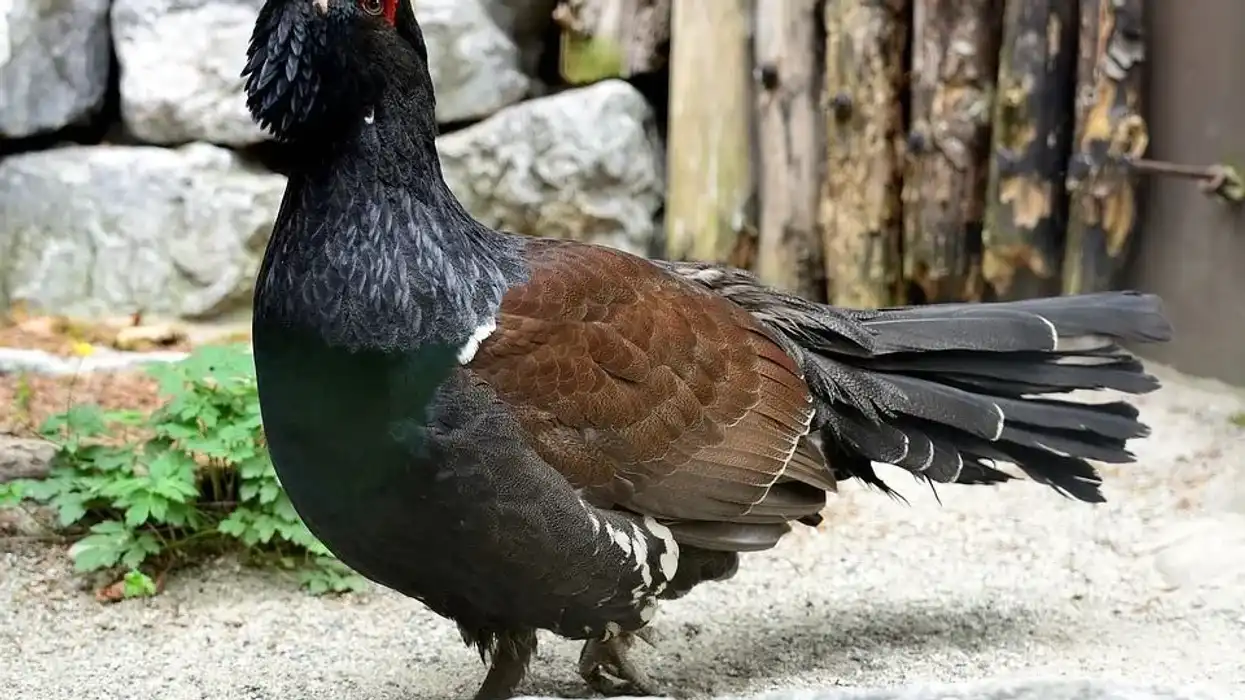The crested barbet is a type of bird found in the sub-Saharan region of Africa. It belongs to the Trachynophus and the family of Lybiidae. The scientific name of the bird is Trachyphonus vaillantii to commemorate the French naturalist Francois Levaillant.
These small, stout birds are known for their brilliant coloring, including the red and yellow crest on its head. This vocal bird is also known for its distinct call, which they keep making incessantly.
They are also quite calm around humans and often visit well-maintained bird feeders for food and shelter. In the wild, they look for food while foraging on the ground. It also looks into the crevices of trees and other cavities, looking for insects.
These birds are not migratory in nature, but they have been noted to fly short distances to surrounding areas in order to find the best water source. These birds are also the victim of interspecies brood parasitism as they often end up incubating eggs from the honeyguide species.
Keep reading for more amazing facts and references about the crested barbet found in South Africa!
If you like this article with facts about the crested barbet, check our other articles with great facts about the cockatoo and red backed shrike.
Crested Barbet Interesting Facts
What type of animal is a crested barbet?
A crested barbet (Trachyphonus vaillantii) is a type of bird that belongs to the family of Lybiidae.
What class of animal does a crested barbet belong to?
The crested barbet (Trachyphonus vaillantii) belongs to the Aves class of animals.
How many crested barbets are there in the world?
The exact population of the crested barbet bird (Trachyphonus vaillantii) has not yet been calculated by scientists and researchers. However, they consider the population distribution of the bird species to be quite stable and not at any immediate risk of decline or extinction.
Where does a crested barbet live?
The crested barbet range map extends over the sub-Saharan region of Africa, including the countries of Mozambique, Botswana, and Zimbabwe. In addition to that, it is also found in the northeastern regions of South Africa and the northern parts of Namibia, where it can find its ideal habitat and plenty of fruit and insects to eat.
What is a crested barbet's habitat?
The crested barbet's ideal habitat is found in forests, woodland, scrublands, and savannahs. In addition to that, the habitat of these birds also extends to exotic plantations, gardens, and parks along with riverbeds and suburban areas.
Who do crested barbets live with?
The crested barbet (Trachyphonus vaillantii) mostly exhibits solitary behavior but is also quite protective of its territory. However, these birds are sometimes also noticed to roam around in pairs as they feed on the ground.
They also become quite aggressive about their territory during the breeding season and try to defend their nest from nest competitors and the territory of other birds. These birds also attack other nest competitors and mammals if they feel that their nest or the eggs they have laid are under threat.
How long does a crested barbet live?
The average lifespan of the crested barbet, found in countries like Mozambique, Zimbabwe, and Botswana in the sub-Saharan African region of the world, has been observed to be approximately 8-10 years.
How do they reproduce?
The crested barbets are monogamous in nature. Once a male and a female have mated during the breeding season, the pairs begin the process of nesting and building the perfect nesting site.
They dig a hole in a tree branch in order to build the breeding nest in the hole where they can lay eggs. These birds do not have a particular breeding season and can give birth to five broods a year.
After the female has laid one to five eggs, the incubation period begins. The incubation period for the eggs lasts for 13-17 days.
Once the incubation period is done, the eggs that the female has laid start to hatch. After the eggs hatch, both the male and female parents form pairs and look after the young crested barbet juvenile for a month or so.
What is their conservation status?
The International Union for Conservation of Nature (IUCN) has listed the crested barbet found in South Africa under the category of Least Concern in their Red List.
Crested Barbet Fun Facts
What do crested barbets look like?
This small-sized bird found in South Africa has a large, thick bill that is pale yellow in color. The bill also has a black-colored pointed tip. Both the male and the female bird look similar with colorful heads full of red and yellow feathers.
Their neck is black in color. Their throat is mostly plain, pale yellow in color. Their wings and breast is marked by a black colored band with white dots on top of it.
The lower back of the bird is yellow in color. A small red spot among the yellow feathers can also be noticed on the breast of the bird. Their eyes are black in color, while their legs and feet are gray.
The young juvenile birds look similar to the adults but are not as bright yellow in color. The plumage of the young bird is browner as compared to the adults. The neck of the juveniles is of a dark brown color.

How cute are they?
Crested barbets found in South Africa are extremely cute! This small, vocal bird, crested barbet from Africa, has a beautiful, multicolored plumage and a black crest which makes it quite attractive. Its call is also quite distinct. The colorful crest on its head is also very eye-catching.
How do they communicate?
Crested barbets from Africa generally use a trill-like sound and call to communicate with each other. The crested barbet call or trill is quite unique but not melodious at all.
It has a trill that sounds like a 'di-di-di' call. This bird is extremely vocal and may keep calling for up to five minutes without any break. When they feel threatened or alarmed, the trill or sound of crested barbet resembles 'kek-kek-kek' that alerts the other members.
How big is a crested barbet?
The average range of length of the birds from this species is around 9-10 in (22-25 cm). It is almost twice the size of the Cape may warbler, which grows up to a long range of 4.7-5.5 in (11.9-13.9 cm).
How fast can a crested barbet fly?
While the exact speed of the crested barbet flying has not yet been estimated, they are not very strong fliers. They can fly easily through short distances at a time.
How much does a crested barbet weigh?
The average weight range of the crested barbet from Africa is approximately 2.4-2.5 oz (68-70 g).
What are the male and female names of the species?
There are no distinct, unique names for the male and female members of this African barbet species. Consequently, they are usually referred to as a male or a female crested barbet. Sometimes, they are also referred to as a cock or hen informally.
What would you call a baby crested barbet?
A baby crested barbet does not have a specific name. Subsequently, following standard terminology, it is usually referred to as a crested barbet nestling or a crested barbet chick.
What do they eat?
The birds of this species eat different kinds of fruits along with seeds and vegetables. They also feed on insects like dragonflies, cicadas, beetles, crickets, snails, and moths.
Are they poisonous?
The crested barbet is not known to be poisonous. They are also not dangerous and are not known to cause harm to human beings.
Would they make a good pet?
Crested barbets with their wonderful black crest can be kept as pets, but they are quite demanding, unlike more peaceful pet birds such as the Fischer's lovebird. They require well-planted, large aviaries to live in and can fly easily through cages.
They also need to be kept in a warm habitat during the winter months. They also have a very specific diet in captivity, and they need to be fed properly. Their food diet usually comprises a mixture of seeds and fruits.
Did you know...
The South African crested barbet is also informally called a 'fruit salad'! It is called so because of its vibrant, multicolored plumage and its diet, which includes fruits along with insects and seeds.
There are different types of crested barbet-related birds like the lilac crested barbet, rainbow crested barbet, and Kruger Park crested barbet.
How do you attract crested barbets?
African crested barbets are mostly welcome in bird-friendly backyards and gardens because they eat snails and other insects from these places.
The easiest way to attract crested barbets to gardens would be by making large birdhouses in a tree branch or nests where they can come and rest. Planting fruit trees like guava fruit or berries in the gardens can also help in attracting barbets as it will keep them fed.
They generally prefer to live in a hole in trees in exotic plantations and gardens or rotten trees in the woodlands.
Are crested barbets endangered?
Crested barbets are not classified as Endangered by the IUCN in its Red List. The population trend of crested barbets is considered to be quite stable, so they are listed under the Least Concern category.
However, these birds are often attacked and killed as they often enter plantations and damage the fruits and crops growing there. In addition to that, these birds also face the risk of poaching due to the illegal pet trade.
Here at Kidadl, we have carefully created lots of interesting family-friendly animal facts for everyone to discover! Learn more about some other birds including palm warbler facts and American pipit facts pages.
You can even occupy yourself at home by coloring in one of our free printable crested myna coloring pages.









